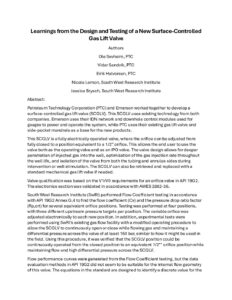Learnings from the Design and Testng of a New Surface-Controlled Gas Lift Valve
Abstract:
Petroleum Technology Corporation (PTC) and Emerson worked together to develop a surface-controlled gas lift valve (SCGLV). This SCGLV uses existing technology from both companies. Emerson uses their IDN network and downhole control modules used for gauges to power and operate the system, while PTC uses their existing gas lift valve and side-pocket mandrels as a base for the new products.
This SCGLV is a fully electrically operated valve, where the orifice can be adjusted from fully closed to a position equivalent to a 1/2” orifice. This allows the end user to use the valve both as the operating valve and as an IPO valve. The valve design allows for deeper penetration of injected gas into the well, optimization of the gas injection rate throughout the well life, and isolation of the valve from both the tubing and annulus sides during intervention or well stimulation. The SCGLV can also be retrieved and replaced with a standard mechanical gas lift valve if needed.
Valve qualification was based on the V1/V0 requirements for an orifice valve in API 19G2. The electronics section was validated in accordance with AWES 3362-36.
South West Research Institute (SwRI) performed Flow Coefficient testing in accordance with API 19G2 Annex G.4 to find the flow coefficient (Cv) and the pressure drop ratio factor (Rp,crt) for several equivalent orifice positions. Testing was performed at four positions, with three different upstream pressure targets per position. The variable orifice was adjusted electronically to each new position. In addition, experimental tests were performed using SwRI’s existing gas flow facility with a modified operating procedure to allow the SCGLV to continuously open or close while flowing gas and maintaining a differential pressure across the valve of at least 150 bar, similar to how it might be used in the field. Using this procedure, it was verified that the SCGLV position could be continuously operated from the closed position to an equivalent 1/2″” orifice position while maintaining flow and high differential pressure across the SCGLV.
Flow performance curves were generated from the Flow Coefficient testing, but the data evaluation methods in API 19G2 did not seem to be suitable for the internal flow geometry of this valve. The equations in the standard are designed to identify a discrete value for the flow coefficient (Cv) and the pressure drop ratio factor (Rp,crt), which is not ideal for this valve design.
PTC performed Computational Fluid Dynamic (CFD) analysis and observed a good correlation between the analytical and test results. The CFD was used to make a curve showing change in flow rate vs. change in variable orifice position, as this was the most important information to the end user.
There may be an opportunity moving forward to broaden the scope of API 19G2 to include optimized testing and analytical methods for variable-orifice valves. PTC and Emerson will continue to work with the end user to find the best way of providing a gas lift design setup for wells employing this electrically operated gas lift valve.

